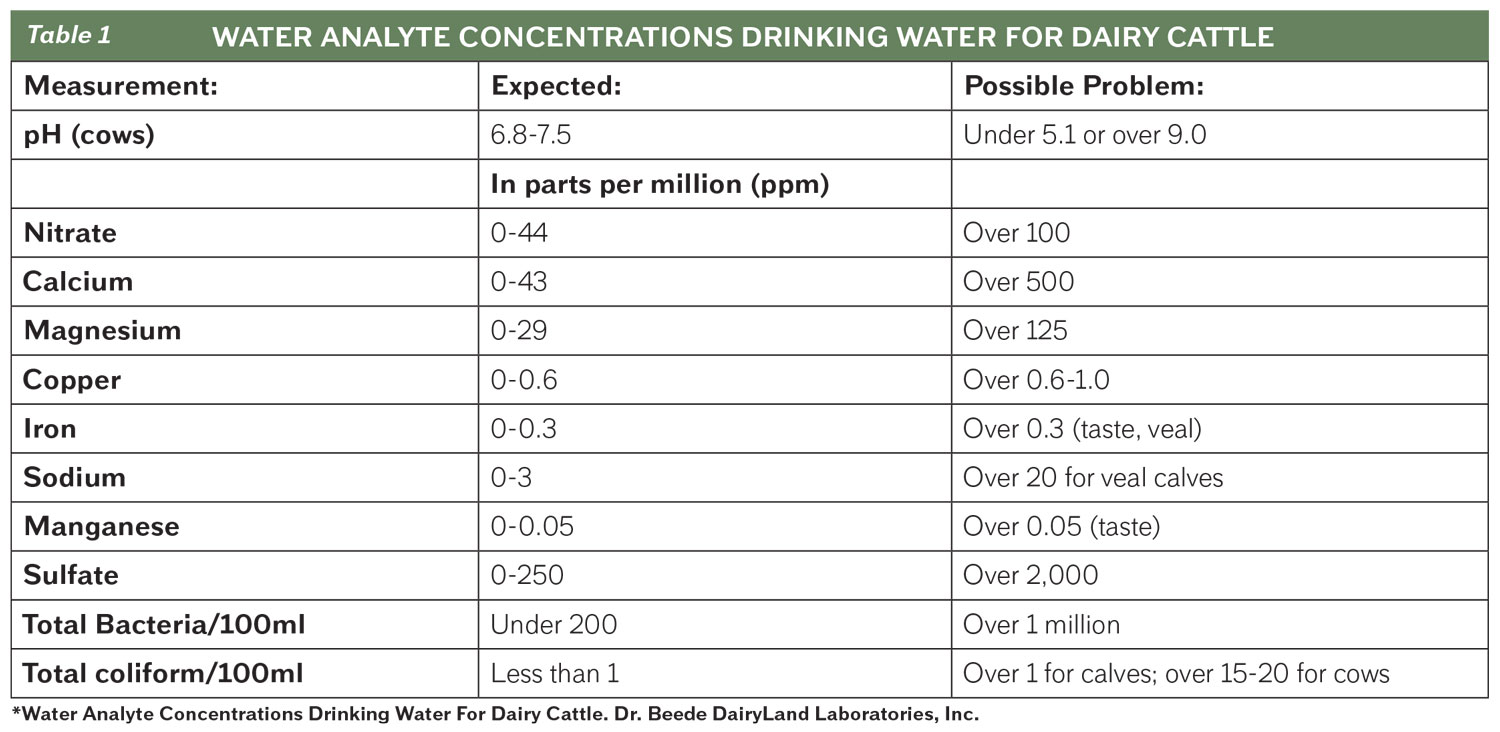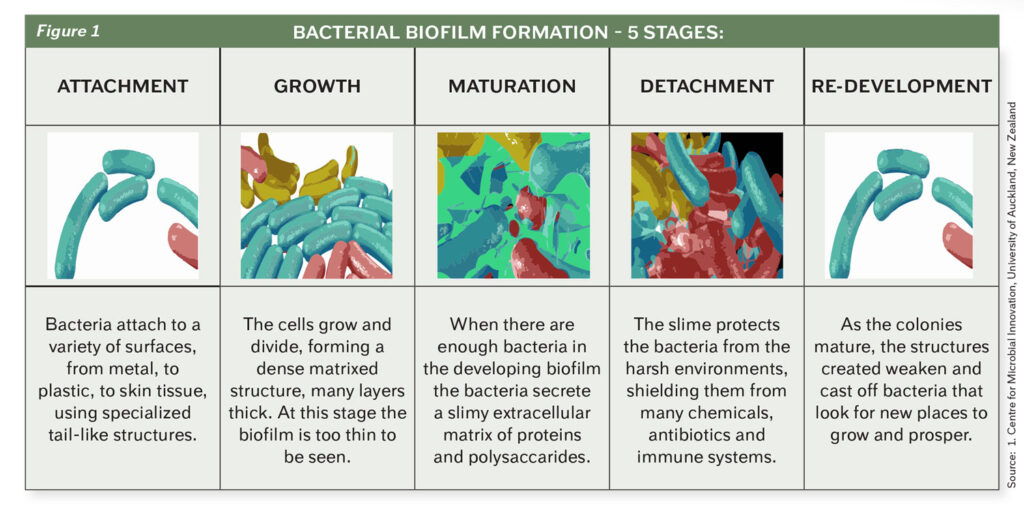Water: The Forgotten Nutrient
Click here to view as PDF: Water: The Forgotten Nutrient
 By Cassy Golburg, B.A. Livestock Specialist
By Cassy Golburg, B.A. Livestock Specialist
Water is the most vital nutrient for livestock and crucial to many functions in the body. An animal’s body is made up of 50-80% water and it helps regulate temperature, spread nutrients throughout the body and eliminate waste. Several factors affect an animal’s water requirement including weather, age, production level and life stage. Despite the importance of water, water quality is often overlooked. Offering easy access to clean water is an important factor when considering the health and productivity of your animals. Just ask yourself…would you drink out of your animal’s water cup or water trough?
Water Quality: What Does It Mean?
There are two basic categories of contaminants that can negatively affect water quality. They are: 1) pathogens like bacteria, protozoa and viruses and 2) inorganic components such as minerals and nitrates. Understanding how each of these categories of contaminants impacts the water livestock drink is important in putting together a plan to improve water quality. The best place to start is with a water test.
Water Testing
Testing water annually is considered a best practice on many operations while more frequent testing is recommended during a drought or if a shallow water source is being used. Testing should be done at a certified facility and many labs will provide sample collection kits free of charge upon request. A typical livestock water test includes pH, total dissolved solids, total soluble salt, salinity, hardness, iron, manganese and other trace minerals, nitrates and sulfates. Common tolerance levels for dairy cattle can be seen below in Table 1*.
Biofilm:
The first category of contaminants include pathogens such as bacteria, protozoa and viruses. Most often, bacteria grow and create a slimy film on the inside of the water system of a farm. The scientific word for this slimy film is biofilm and it is defined as: thin, slimy films of bacteria, protozoa and viruses adhered to a surface in a resistant matrix of cellular materials. Once these bacteria start to grow inside water lines, valves, water nipples or troughs, they secrete a sticky protein that helps them adhere to the surface.
An ATP meter is a tool that can measure biofilm levels in the water. Readings above 200 RLU indicate a biofilm is present. The meter has a max reading up to 9,999 RLU and on occasion, the Crystal Creek® staff has seen water test this high. In many cases, this slimy film can be felt by running a finger along the plastic surface underwater. If you can manually feel the biofilm in your water system, it is negatively affecting livestock. Figure 1 shows how biofilms develop over time.
The most effective way to control biofilm formation is with the routine injection of chlorine dioxide into the water line. Typical maintenance injection rates range from 0.5% to 1% for most livestock operations. Crystal Creek® offers AquaSoar™, a chlorine dioxide water injection system. The AquaSoar™ system is a two-component activator/base system that can create chlorine dioxide on site. This can then be injected into the water system to break up biofilm, help reduce iron in the water and is approved for livestock use up to 4 ppm. The amount of chlorine dioxide injected can be adjusted over time. For instance a producer may wish to start at 4 ppm to break up biofilms and reduce down to a maintenance level of 1 ppm. For more information on the AquaSoar™ system, see Dr. Ryan Leiterman’s article, “Water Hygiene, How Often Do You Think About It?” in the April 2021 Crystal Creek® Newsletter. The AquaSoar™ system is more effective and less expensive than hydrogen peroxide.
Nitrates
Nitrates can get into the water supply through fertilizer, animal waste or decaying organic matter. In cattle, nitrates digested in the rumen convert to nitrites, which is ten times more toxic to the animal. Poisoning occurs when enough nitrite is present in the blood to cause oxygen deprivation. For cattle, problems can start occurring when levels are over 100 ppm. Symptoms of nitrate poisoning in cattle vary, but often have a rapid onset. Difficult and/or noisy breathing, rapid pulse, weakness and staggering are all possible symptoms of nitrate poisoning. Keep sources of nitrates away from water supplies to prevent leaching. Livestock operations should be kept 100-200 feet away from wells to reduce the risk of contamination.
Iron and Manganese
High iron and manganese levels can affect the taste, smell and appearance of the water, decreasing water consumption and leading to production and health problems in the animals. The taste of the water is affected once manganese levels reach .05 ppm and iron levels of .3 ppm, respectively. Having high levels of iron and manganese in the water can also have a negative effect on nutrient absorption within the animal. These cations can interfere with other nutrients in the GI system, binding them and preventing their absorption into the body. Elevated iron and manganese levels are one of the leading causes of biofilm growth within the farm’s water system. High amounts of iron and manganese in the water encourages bacteria growth, which leads to a biofilm buildup if troughs and waterers are not cleaned properly. The AquaSoar™ system can help reduce iron levels through ionization.
Sodium
Livestock can have varying sensitivities to sodium levels. Water that has passed through a water softener can have a high level of salt, and should not be used to mix milk replacer without testing. Sodium levels in water over 1,000 ppm can affect calves and cause scours, lethargy, abnormal gait and muscle twitching. Poultry are also more susceptible to increased levels of sodium in the water. This increases water intake, which leads to higher litter moisture and can adversely affect air quality.
There are many things a producer can do to keep livestock from suffering from sodium toxicity. Checking water supplies frequently and making sure troughs are clean can reduce the risk. Producers should also make sure that water does not accumulate in salt lick or block containers.
Sulfates
High levels of sulfates in water will have a bitter taste. Younger animals are more susceptible to sulfate levels, which can cause scours in calves. Very high levels of sulfates can cause central nervous system damage or death. These high levels can also tie up copper so water should be tested if an animal has a copper deficiency. Sulfate levels over 50 mg/L can affect poultry if the sodium level is also over 50 mg/L. If both are present, this can have a laxative effect on the flock. A water filtration system can help remove sulfates and other contaminants. An alternative water source can also be used.
There are many benefits to ensuring livestock are properly hydrated. A study conducted in 2014 found that calves given water from birth had improved growth and development compared to those given first water at 17 days of age. The calves given water at birth had better hip height, body length and feed efficiency. A Utah State University study found that calves are more likely to drink from buckets that are rinsed daily compared to those that are only rinsed once a week. The study also found that the calves had higher daily gains and weaning weights. Ensuring water is clean is an effective way to ensure proper hydration.
Ensuring livestock have access to plenty of clean, fresh water can have a positive effect on not only the animal’s health, but on an operation as well. To learn more about the AquaSoar™ system or to review your water analysis results, contact Crystal Creek® at 888-376-6777 to speak to a nutritionist or livestock specialist.
References available upon request.


